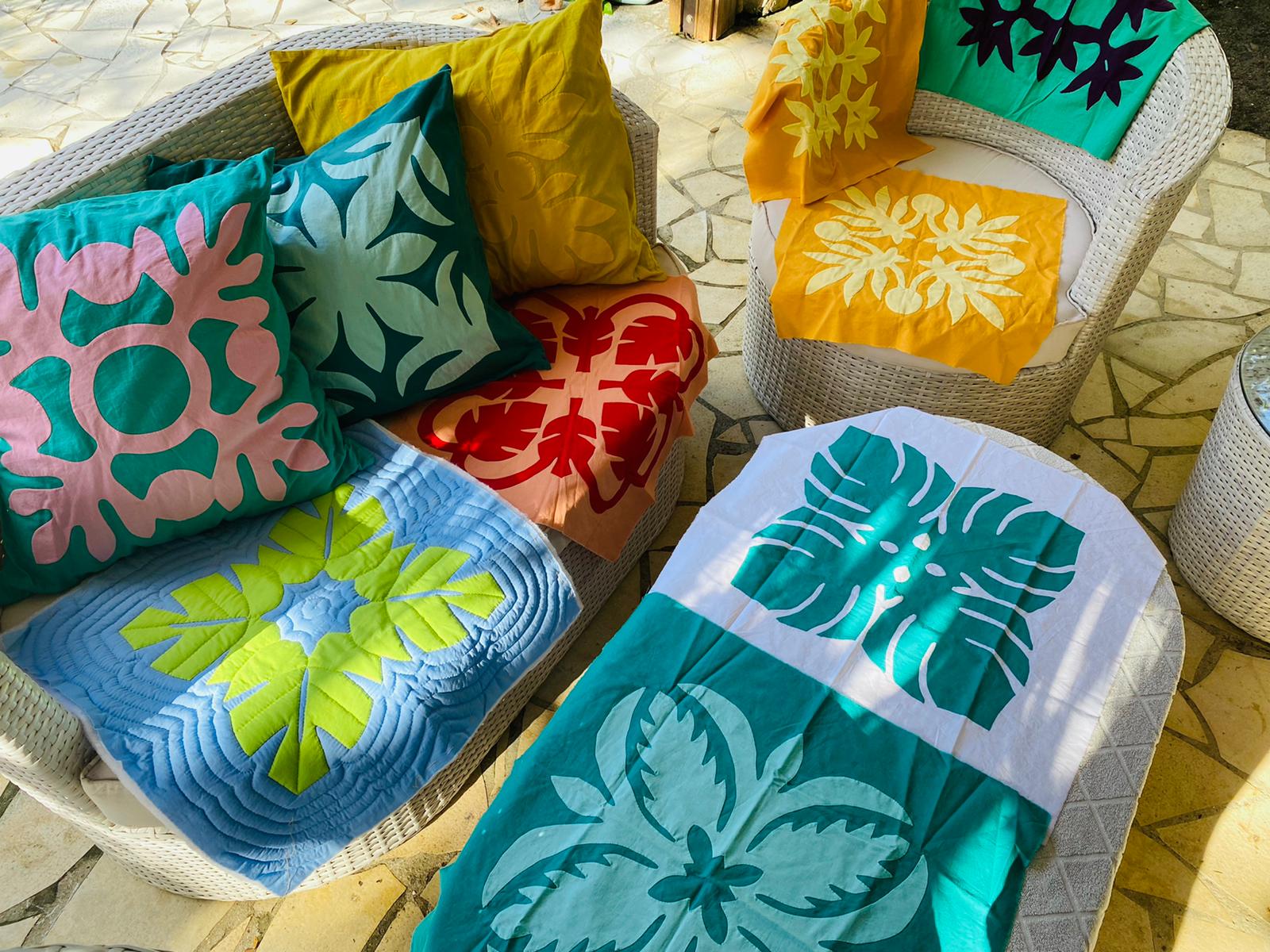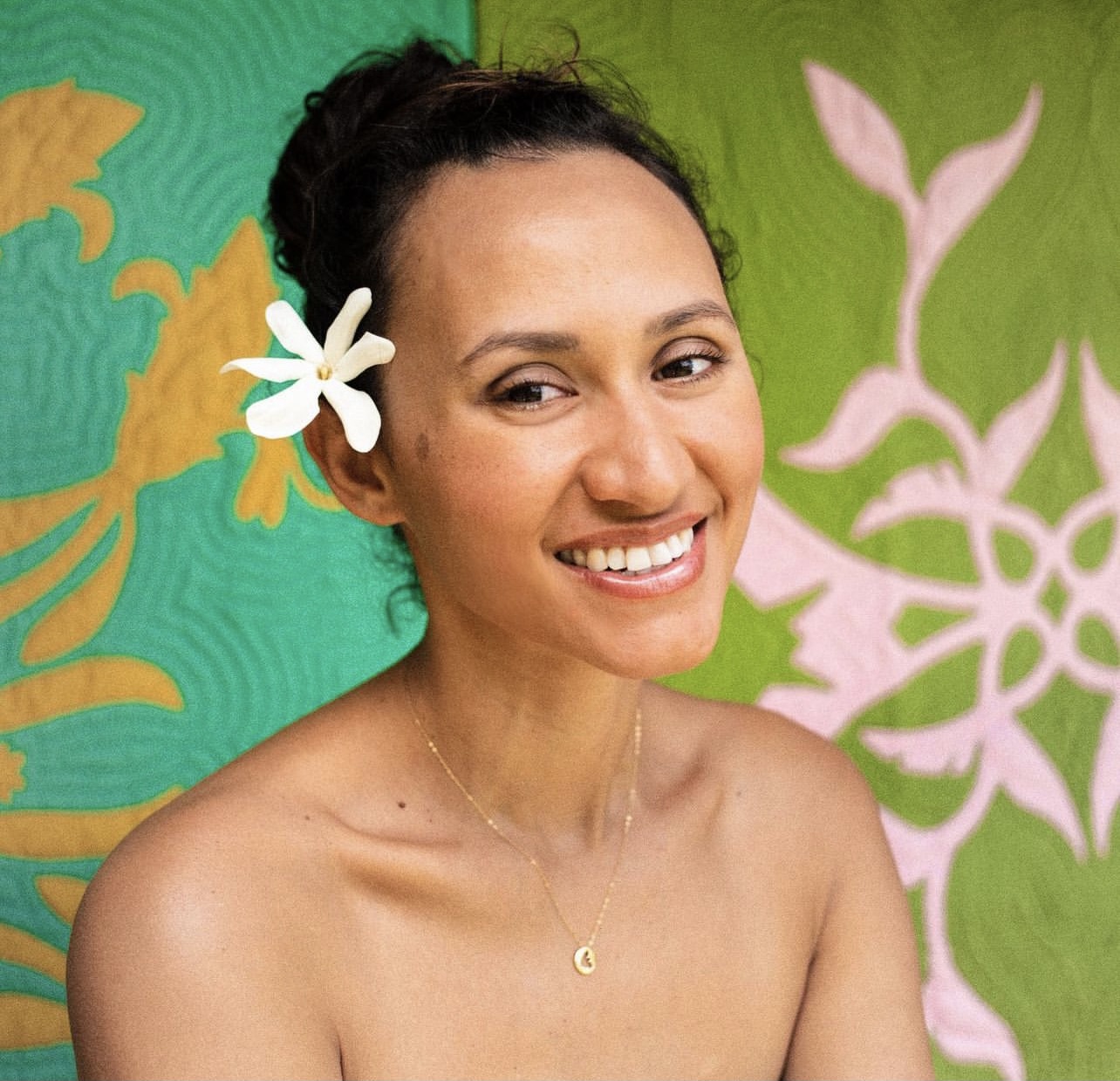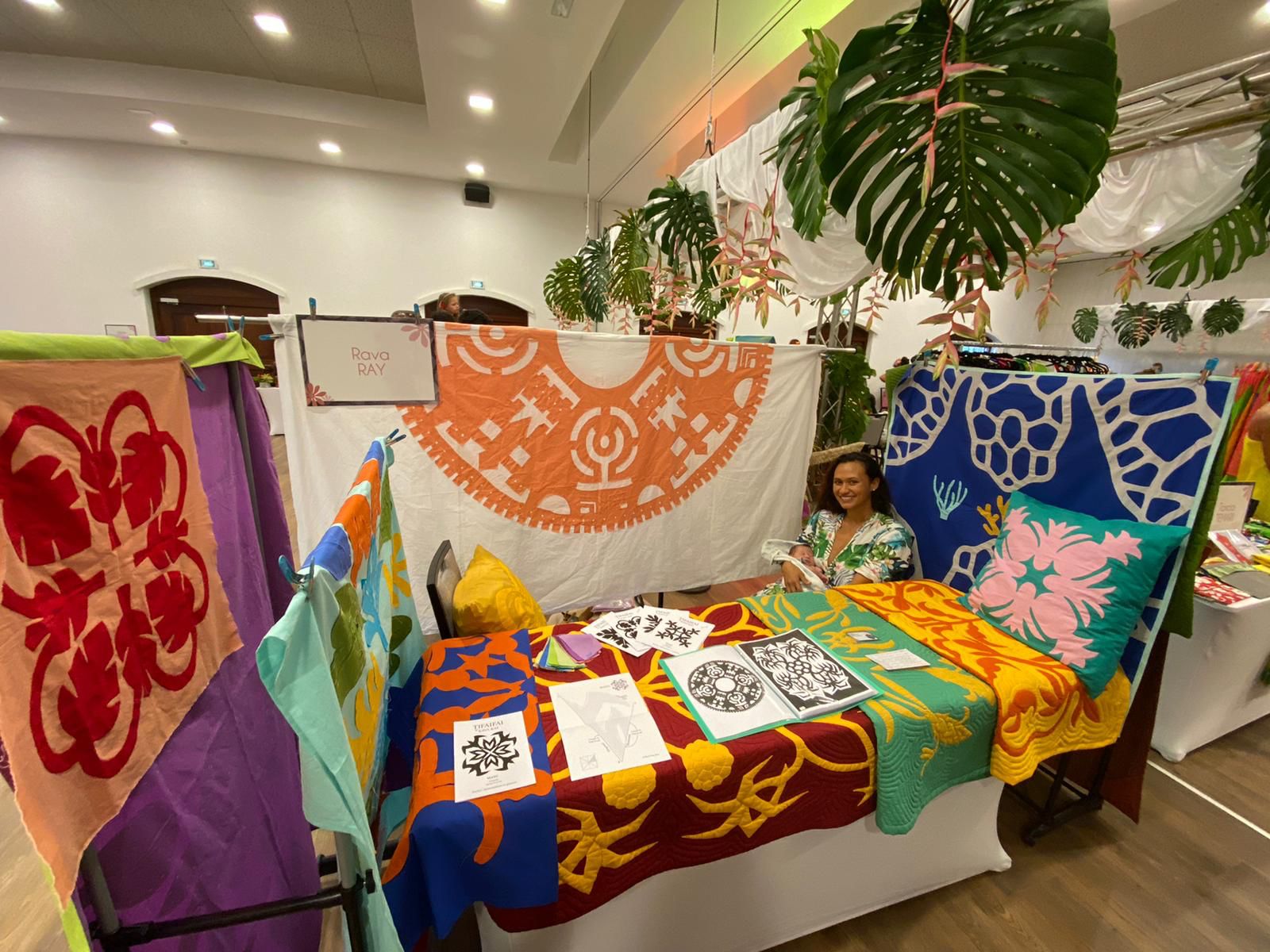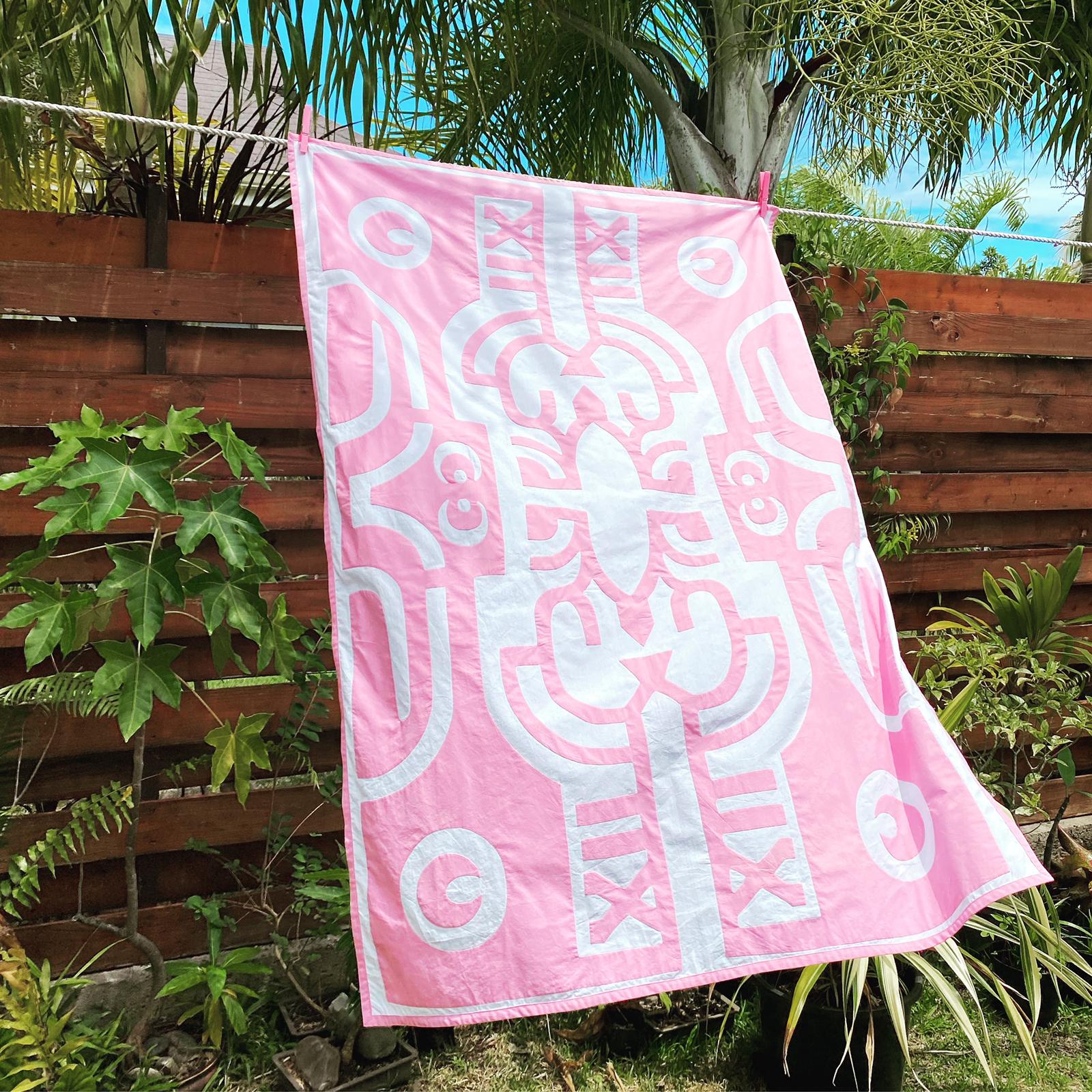Tīfaifai by Rava Ray: a true manifestation of Polynesian creativity and love for Nature.

From the moment I walked into the room, the circle of flowers caught my eyes. At first glance, the tīfaifai illuminated the room, the association of colors heightening the geometrical motifs and representing tiare flowers which seemed to stick out from the blanket or cover, or hanging. It is obviously a piece of beauty and once you realize the exquisite craftsmanship behind the sheet you want to hang it everywhere because this is something for all to see.
The first hand-made tīfaifai I’ve seen, is what we call a tīfaifai pū, originally from Austral islands, which consists in mending together small pieces of fabric they cut into the form of either diamond, square or rectangle shapes and many other geometrical forms to eventually reveal a magnificent mosaic. From Society islands, we know the tīfaifai pā’oti commonly seen around Tahiti. It involves a layering and sewing of patterns onto another sheet, displaying a gorgeous tableau of Nature, inspired from our direct Polynesian environment such as tiare, aute (hibiscus), uru (breadfruit) patterns and the infinity of options nature offers.

Polynesian women have sublimated and transcended the practical purpose of the making of tīfaifai, which was originally to recycle scraps of fabric. Polynesian arii vahine (high ranking women) were taught the Anglo-Saxon technique of patchwork with the English missionaries’ wives back in the 18th century. While tapa cloth was in use, the patchwork turned out to be a real blessing for many reasons including a new artistic expression and use of their power of creation.
Ravahere Atiu Shastid aka Rava ray is sharing, here, her passion for tifaifai making. Exactly like tifaifai, this young mother is a mix of origins, and is bringing the best out of her cultural legacy.

As tīfaifai definitely brightens up a room, Rava has lit up several scenes from her performance as fierce competitor for best dancer in heiva 2018, to Fashion Weeks in Hawaii through her glamorous dresses and designs passing by Vogue magazine exhibiting hand-made jewelry with hand-picked shells. American by her father and Polynesian/French by her mother, many options were unfolding before Rava in terms of university studies. Hawaii and New York had her heart at the time, she’s becoming a talented designer to eventually get her degree in Design and Fashion from Parsons The new school for Design, in 2017. She has been lucky enough to combine her urge to create and her passion for travels, working on Hawaiian Airlines as a flight attendant for almost ten years. However, she has never felt as fulfilled as she is, today, when she’s making a tīfaifai from home, allowing her to look after her family and stay close to her children.
« When my kumu passed away and he never got to see my finished work, I kept thinking this is just really sad if somebody is perpetuating the culture he lives into and then he dies then the culture dies with him! I had a lot of reflecting and meditating upon it. It’s actually happening. He died and I was one the people that had a little bit of his knowledge. My kumu’s name : John Serrao. »
Back in Tahiti, Rava felt like the art of making tīfaifai wasn’t as alive as it was in Hawaii. She wanted to create spaces, gathering people around the tīfaifai. But feelings of unworthiness and fear to offend people and doing the wrong manner held her back until her kumu (teacher in Hawaiian language) passed away. One day she had just decided that keeping the culture alive was more important than getting her feelings hurt. In 2021, the adventure had begun and she was hosting people in her house and giving quilting classes and tīfaifai classes which are slightly different.
« The last process is gifting, or displaying on a bed or in your house, I like the idea that tīfaifai need to live, I don’t think they should just sit in a drawer in the dark. I think that they should be appreciated and loved, touched , and they should be part of the family. »

Tīfai: to patch, to mend in Tahitian.
The making process consists in six crucial steps:
1. Drawing and designing what inspires you.
2. Drawing inspiration into a pattern which will define the constraints and size of your blanket, or pillow and cutting into the fabric.
3. Pinning the patterns in place on the fabric underneath, making it symmetrical and making sure the spacing are the same everywhere.
4. Basting the pattern onto the back of the fabric so it doesn’t move around when you do the actual sewing.
5. Stitching whether it’s with a machine or by hand.
« I was presented with a ti leaf pattern and breadfruit pattern and I had this deja vu. I’ve looked at these 2 patterns and thought to myself oh my gosh I’ve been here before and I know which pattern I need to pick if I want to keep doing this, so I’ve picked the ti leaf pattern which was the more simple one not as elaborate as the breadfruit was. Honestly it made all the difference, after picking the ti leaf pattern I’ve finished it. »

Between Rava and the tīfaifai, it wasn’t love at first sight. She remembers the first class she took in Kauai, wasn’t a great success, it didn’t hook her in. So much so that, years later when she was asked to attend another quilting class she had forgotten her first experience until she had to choose between the two same patterns again, her choice this time clearly determined the next chapters in her story with the tīfaifai. Even though she thinks practical now in terms of patterns, making them accessible for students, the first pieces she made, had patterns, heavy with meanings, and which were connected to personal life experiences.
In fact, one of her first projects she did with her kumu was a 1mx1m piece featuring stingrays to remind her of her home island Moorea. Another one was displaying several different leaves connected to her Mother’s garden in Maatea still in Moorea. Lauhala (pandanus in Hawaiian language) leaves and fruit patterns play also a great role in her nuclear family bonding them all in love and protection. These patterns were representing her fresh costume while performing her dance in heiva competition, when she met her children’s father and partner in life Lolo but our artist also picked fara (pandanus in Tahitian) patterns to incorporate them to her children’s tīfaifai so that their parents’ love story will be integrated to their childhood.

« There’s a few reasons I feel really good about sharing this passion with our generation, past and future, for me. One of them is keeping a link with our ancestors, i really like to think about like a mythical grandmother, my grandmother never did tifaifai, i like to think about the older women that did this that sort of led to me, and how when i’m doing the art i feel very connected to all grandmothers that used to do it so i feel really connected to my roots it kind of like anchors me, gives me this link between me and people who have come before me and also played a role into creating me. »
The life of our dancer, artist, and vector of transmission has taken a whole new dimension since tīfaifai has entered her life. Despite the difficult aspects of being an artist just like financial uncertainty, vulnerability in front of a public that can show love just as well as no mercy, she firmly believes in her activity. Not only meaningful gifts and great art to master, making tīfaifai opens to another appreciation of life moments. In a world where most people run after their life, tīfaifai slows the pace, offers different spaces for one on one time with yourself, or also can be experienced as a community.

« I want to create spaces to gather and do this together the way that I experienced it when I was in Hawaii. We met every Saturday at Lolani palace which is already a special place. On the day we met, we would have breakfast and coffee together, talk, and everybody would share about their lives and share their project with each other. People come and go as they please for 3 or 4 hours. So hoping I’ll be able to create a community like that and create like a newfound love for the tīfaifai. »
We are hoping to see our beautiful and strong vahine’s dreams, goals achieved! Taking up the Art of tīfaifai to where it belongs, to the level of Artwork. She wishes to see her students and many more, modernize and create their own designs, reviving the art. Like her ancestors she’s determined to pass on the torch and help the evolution and valorization of tīfaifai.
« I hope to see young and old practicing tīfaifai together, hoping it becomes a part of ordinary household just like dance. » Rava Ray
